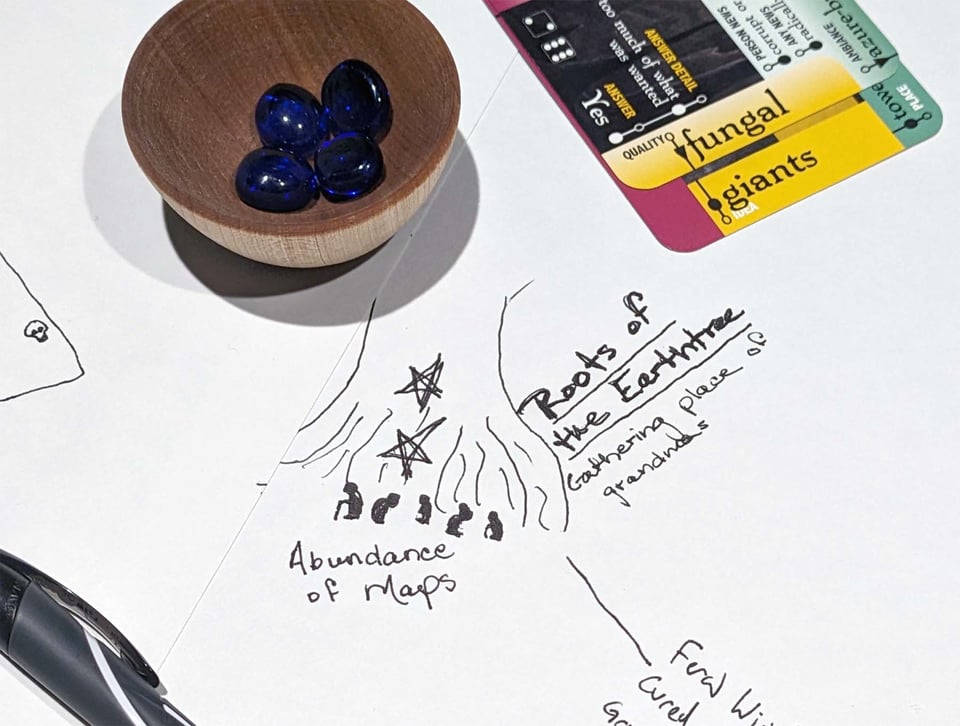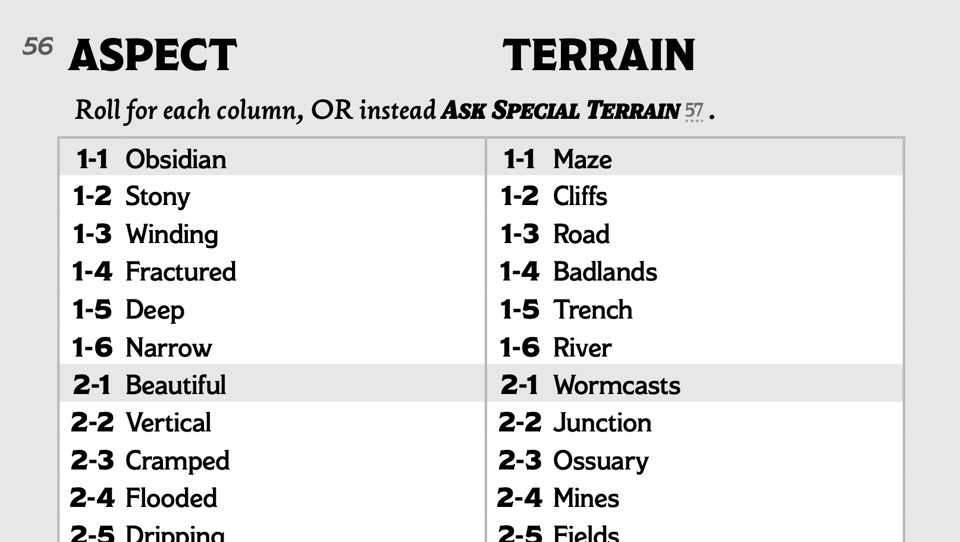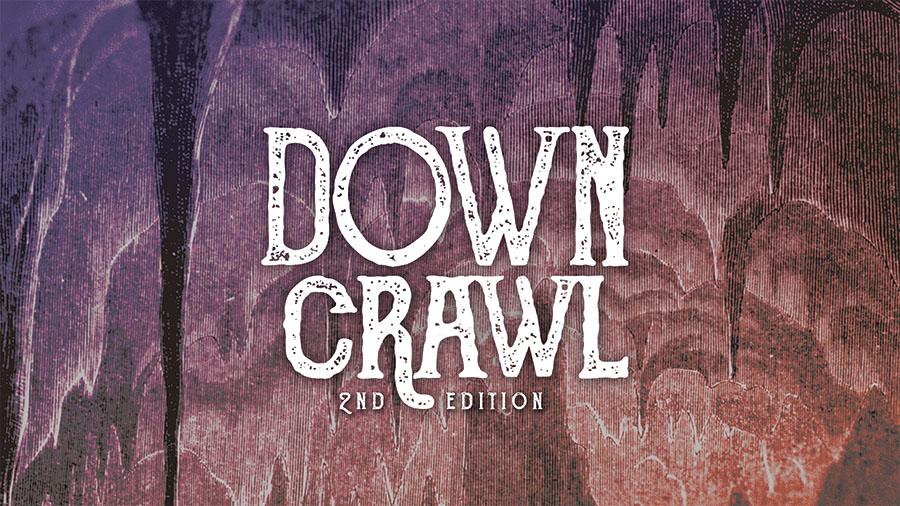Downcrawl: Making Up The World
Welcome to the Downcrawl Digest! This is my first post about the new edition of this collaborative tabletop game of exploring an infinite underworld. I plan to post every two weeks or so with bite-sized previews of fun stuff from the new edition. Thanks for the interest; on with the first post!
One of the big differences between original Downcrawl and Downcrawl 2E is that generation of weird places and peoples happens live at the table, rather than offline between sessions. (By default, anyway—you can still do it the old-school way if you prefer.) This is one of my favorite parts of the new system and worth a bit of demonstration by example.

In old Downcrawl, there was a chapter called “Generators” with subsections for creating Folk (the unique fantasy races that populate your particular version of the Deep, Deep Down) and Volumes (the strange underworld places you’ll explore). The idea was that the GM would generate complete Folk and Volumes between each session, to always have some “in the bag” for the players to discover.
This Is The Way things are often done in tabletop campaigns, and it’s certainly fun to spend a quiet Saturday worldbuilding by yourself in advance of a game. But it’s also time-consuming. Volume generation in Downcrawl 1E had ten steps, some of which involved multiple spontaneous acts of creation in a row, like “come up with 3-5 interesting and creative ideas for encounters here.”
This can be a lot, alone by yourself, even for experienced worldbuilders. Besides the time cost, A GM risks putting a lot of effort into creating Folk or Volumes that players never encounter… or becomes tempted to railroad them towards existing creations, making the campaign less responsive to what the players are actually interested in exploring.
Downcrawl 2E takes a different approach. By default, no Folk or Volumes exist in the world until the moment your players need one. When they do, you generate just enough detail to meet the needs of the current moment, only fleshing things out further if the players continue to explore this place or people.
How does this work? Let’s look at Volumes. At various points in the game (such as when updating your maps, or asking fellow explorers for rumors), you might be instructed to play the move Spark A Volume. This tells you to roll on a few adjacent tables, Volume Theme + Terrain, to get a core idea for a new, unvisited place. You might get a result like:
ruined by magic + flowering chasm
prison + flooded wasteland
utopia + vast glacier
This is enough to spark a sentence or two about this distant place, which is all you need at first: “I’ve heard of a utopian land far from here, tunneled into the heart of a massive vein of ice. Despite the chill, they say none there ever go hungry.”

If later the players want to investigate this place further, or plan a journey to visit it, you can generate additional information (called Details), enhancing your picture of this place. For instance, you might learn that the utopian glacier city has an Abundance of Monsters, suggesting a threat to the idyllic life there. As you learn more Details, it becomes easier to Plan a Journey to this Volume; by the time you arrive, you will have learned six unique Details, enough to paint a complex and interesting picture of this location.
By default, results are generated by rolling 2d6 and consulting the appropriate table. (Some tables, like Terrain, are two-parters: you roll 2d6 for the first word and another 2d6 for the second).

The optional Downcrawl Deck speeds this process up considerably: you simply draw a card and find the label you need for your answer. Two-part prompts are even easier; they’re all printed along the card edges, so you just flip the top card over and align it with the matching symbol on the card below to get your compound prompt:

Another fun thing about Downcrawl 2E’s design is that it’s up to you and your table who generates these answers. The GM might do it in secret, behind a screen; the players might do it and announce their results, leaving it to the GM to synthesize them together. You might even decide the players get to synthesize the answers themselves, taking an active role in helping to build the world. (Downcrawl 2E even supports play modes with no GM, or with one solo player—more about how that works in a future post.)
The fun of this just-in-time method is that everyone gets to discover the world at the same time, together, without any wasted generation that never gets seen. It can make sessions feel much more dynamic and player-driven. GMs won’t be railroading players toward pre-planned creations because most of the world is made up on the fly, and players themselves drive the worldbuilding through the sparks they choose to follow up on.
For GMs who do like to prep, it lets them focus on building out the places and peoples the players have already shown an interest in. If, for instance, they’re intrigued by that glacial utopia, you might invent some memorable NPCs who live there, districts of the capitol city, or plan a dungeon buried deep in the ice cracks beneath… and there’s other prompts to help you with those steps, too.

(Related: I’ve started posting a Volume of the Week on social media, where I’ll post a picture of three prompts for a random Volume and briefly flesh it out. You can follow me on X, Instagram, Mastodon, or RSS to see these!)
That’s all for now! In future posts I plan to explain the Downcrawl Deck more thoroughly, talk about how the Impromptu and Solo play modes work, and more… hope you stick around!
—Aaron
Downcrawl 2E is coming to crowdfunding this summer! You can sign up now to get notified when the campaign launches, or subscribe to this newsletter for short posts every other week or so with inside info and sneak peeks at rules, art, and release plans.
